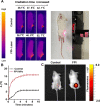Functionalized Magnetic Nanoparticles for NIR-Induced Photothermal Therapy of Potential Application in Cervical Cancer
- PMID: 37360441
- PMCID: PMC10286267
- DOI: 10.1021/acsomega.3c01374
Functionalized Magnetic Nanoparticles for NIR-Induced Photothermal Therapy of Potential Application in Cervical Cancer
Abstract
Photothermal therapy (PTT) holds great promise for cancer treatment with its effective ablation of solid tumors. As the essential core point, photothermal agents (PTAs) with excellent photothermal properties and good biocompatibility could help to fulfill highly efficient PTT. Herein, a novel type of nanoplatform Fe3O4@PDA/ICG (FPI) nanoparticle (NP) was designed and synthesized, which was composed of magnetic Fe3O4 and near-infrared excitable indocyanine green via encapsulation of polydopamine. The FPI NPs showed spherical structures in shape with uniform distribution and good chemical stability. Under 793 nm laser irradiation, FPI NPs could generate hyperthermia of 54.1 °C and photothermal conversion efficiency of 35.21%. The low cytotoxicity of FPI NPs was further evaluated and confirmed on HeLa cells with a high survival rate (90%). Moreover, under laser irradiation (793 nm), FPI NPs showed effective photothermal therapeutic characteristics for HeLa cells. Therefore, FPI NPs, as one of the promising PTAs, have great potential in the field of PTT for tumor treatment.
© 2023 The Authors. Published by American Chemical Society.
Conflict of interest statement
The authors declare no competing financial interest.
Figures







Similar articles
-
A highly efficient polydopamine encapsulated clinical ICG theranostic nanoplatform for enhanced photothermal therapy of cervical cancer.Nanoscale Adv. 2022 Aug 11;4(18):4016-4024. doi: 10.1039/d2na00341d. eCollection 2022 Sep 13. Nanoscale Adv. 2022. PMID: 36133329 Free PMC article.
-
Polydopamine encapsulated new indocyanine green theranostic nanoparticles for enhanced photothermal therapy in cervical cancer HeLa cells.Front Bioeng Biotechnol. 2022 Sep 19;10:984166. doi: 10.3389/fbioe.2022.984166. eCollection 2022. Front Bioeng Biotechnol. 2022. PMID: 36213060 Free PMC article.
-
Indocyanine Green-Based Theranostic Nanoplatform for NIR Fluorescence Image-Guided Chemo/Photothermal Therapy of Cervical Cancer.Int J Nanomedicine. 2021 Jul 17;16:4847-4861. doi: 10.2147/IJN.S318678. eCollection 2021. Int J Nanomedicine. 2021. PMID: 34305398 Free PMC article.
-
Nanoarchitecture-based photothermal ablation of cancer: A systematic review.Environ Res. 2023 Nov 1;236(Pt 1):116526. doi: 10.1016/j.envres.2023.116526. Epub 2023 Jul 22. Environ Res. 2023. PMID: 37487920 Review.
-
Dual-targeted photothermal agents for enhanced cancer therapy.Chem Sci. 2020 Jul 17;11(31):8055-8072. doi: 10.1039/d0sc03173a. Chem Sci. 2020. PMID: 34123080 Free PMC article. Review.
Cited by
-
Magnetically Controlled Intraocular Delivery of Dexamethasone Using Silica-Coated Magnetic Nanoparticles.ACS Omega. 2024 Jun 20;9(26):27888-27897. doi: 10.1021/acsomega.3c07033. eCollection 2024 Jul 2. ACS Omega. 2024. PMID: 38973930 Free PMC article.
-
Macrophage-Based Microrobots for Anticancer Therapy: Recent Progress and Future Perspectives.Biomimetics (Basel). 2023 Nov 18;8(7):553. doi: 10.3390/biomimetics8070553. Biomimetics (Basel). 2023. PMID: 37999194 Free PMC article. Review.
-
(Nano)biotechnological approaches in the treatment of cervical cancer: integration of engineering and biology.Front Immunol. 2024 Sep 13;15:1461894. doi: 10.3389/fimmu.2024.1461894. eCollection 2024. Front Immunol. 2024. PMID: 39346915 Free PMC article. Review.
-
Facile Fabrication of Titanium Carbide (Ti3C2)-Bismuth Vanadate (BiVO4) Nano-Coupled Oxides for Anti-cancer Activity.Cureus. 2024 Jun 1;16(6):e61492. doi: 10.7759/cureus.61492. eCollection 2024 Jun. Cureus. 2024. PMID: 38952587 Free PMC article.
-
Magnetic mesoporous silica nanoparticles as advanced polymeric scaffolds for efficient cancer chemotherapy: recent progress and challenges.RSC Adv. 2025 May 14;15(20):16050-16074. doi: 10.1039/d5ra00948k. eCollection 2025 May 12. RSC Adv. 2025. PMID: 40370857 Free PMC article. Review.
References
-
- Asami Y.; Yutaka U.; Mamoru K.; Yusuke T.; Sayaka I.; Shinya M.; Eiji K.; Toshitaka M.; Isao M.; Keisuke F.; Yuri I.; Tomio N.; Tadashi K. Epidemiologic and clinical analysis of cervical cancer using data from the population-based Osaka cancer registry. Cancer Res. 2019, 79, 1252–1259. 10.1158/0008-5472.CAN-18-3109. - DOI - PubMed
LinkOut - more resources
Full Text Sources
Research Materials
Miscellaneous

